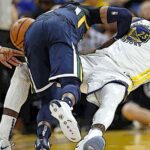In professional tennis, the rules are enforced primarily by the chair and line umpires.
The line umpires use a mixture of hand signals and their voice to indicate whether a ball is in or out of bounds.
Meanwhile, the chair umpire is equipped with a microphone on his high chair and is vocal during the match.
You’ll hear the chair umpire speak regularly throughout the match, shouting remarks such as “out”, “advantage”, “fault” and the score or winner of individual games.
On occasion, you may notice them blurt out the word “let”, which is most common during a player serve.
The tennis “let” is a very unique call in tennis, which doesn’t have an equivalent in any other major sport.
We’ll get into that shortly, but let’s begin by defining the term for those that don’t know…
What is a LET in Tennis?
A let in tennis is a call made by the chair umpire to replay the sequence or point. The call is typically made when the ball touches the net on a valid serve, but also as a result of an in-game distraction. As a result, the score remains unchanged and the sequence is reset.
An in-game distraction would refer to an unforeseen disruption during a tennis rally between opponents.
The disruption can be caused by a moving ball boy, debris or an object flying on the court, or even an animal running on the playing field.
In case you don’t believe me, check out this video of a cat almost getting clocked by a spiked ball during a doubles rally.
You can actually hear the attentive chair umpire call the “let” early to spare the cat from injury.
The call likely caught the player off guard, which is why he followed through on the shot anyway.
What is a LET serve in Tennis?
The service let is the result of the ball hitting the net during a serve, but still manages to land in-bounds (in the diagonal service box).
The umpire calls the “let”, because there is lower chance of the receiving player to return the ball, especially when it catches the net hard and drops onside.
In other cases, the ball will barely graze the net and would normally be playable, however the rules call for the point to be replayed.
There are no limits to the amount of serves following a let call.
However, there is a difference between a let call on the first and second serve.
As a reminder, for every point in a tennis match, players are allowed up to 2 chances on the serve.
The player only gets called for a fault if they fail to serve the ball in the correct service box.
If they repeat the error on the second try, they’re called for a double fault and the point is awarded to their opponent.
That said, a “let” call on the first service is regarded as different than when called on the second try.
In essence, if the player is called for a “let” on the first try, it’s as though the point played is resetting from the very beginning each time.
Should they get called for a service fault, they maintain their second opportunity to serve on the point.
Meanwhile, if the “let” is called on the second serve, the new starting point is as of the second serve again.
Which means that if they are called for a fault after the “let”, the point is awarded to their opponent.
Why is it called LET in Tennis?
The term "let" in tennis has an interesting historical origin.
It is believed to have its roots in Old English and Middle English, where the word "lett" or "letten" meant "to hinder" or "to delay."
Over time, this word evolved and found its way into the lexicon of various sports, including tennis.
The use of the term "let" in this context is fitting because it signifies a hindrance or delay in the normal progression of the game.
The “No Let” Rule
This rule specifically applies to the service let being counted as fair play.
That is, the sequence continues as long as the ball lands in the correct service box after hitting the net.
The rule was once adopted in the ATP Challenger Tour for a 3-month trial, but would be reimplemented after the expiration date.
The idea was to speed up the game time and eliminate phantom “let” calls on serves the receiver could not return.
In the end, the sentiment was that eliminating lets “just makes for more drama”.
While the service “No Let Rule” can be found in the ITF official rulebook, a recent implementation was also short-lived following the 2018 Next-Gen ATP Finals.
Final Thoughts
As a young fan, I never understood the “let” call while watching greats such as Pete Sampras, Andrei Agassi, Steffi Graph and Monica Seles.
In fact, the first time I heard the umpire scream it out, I thought he was saying “net”.
The irony was that a service let is the result of the ball making contact with the net.
That said, I actually learned about the “let” from a video game.
For those curious, that game was Super Tennis on SNES.
I remember garnering multiple “lets” in a row at times because I was trying to pick my spots against the computer opponent.
I’m proud to say that I managed to beat the game in Circuit mode. This meant I had to play multiple tournaments year round with grand slams and other minor events.
The game was released in 1991 with simple graphics, but with all the rules you’d expect in professional tennis.
Furthermore, the game incorporated the same playing surfaces you’d expect in real life: hard, grass and clay.
They even made the ball bounce according to the surface of each stadium.
Good times!
Lastly, there isn’t really any other professional sport that allow for do-overs.
We often hear of the term “mulligan” in golf, where a player can replay their stroke. However, it is not allowed in professional tournaments.
The closest thing to a do-over in any sport would be in baseball.
After two strikes, the batter is allowed to hit as many foul balls during his at-bat presence without striking out.
Every pitch would be officially recorded, so it’s technically not a reset or “do-over”.
But the batter does get another chance to hit.
So, for the time being, the tennis let is truly an unique call in professional sports.






